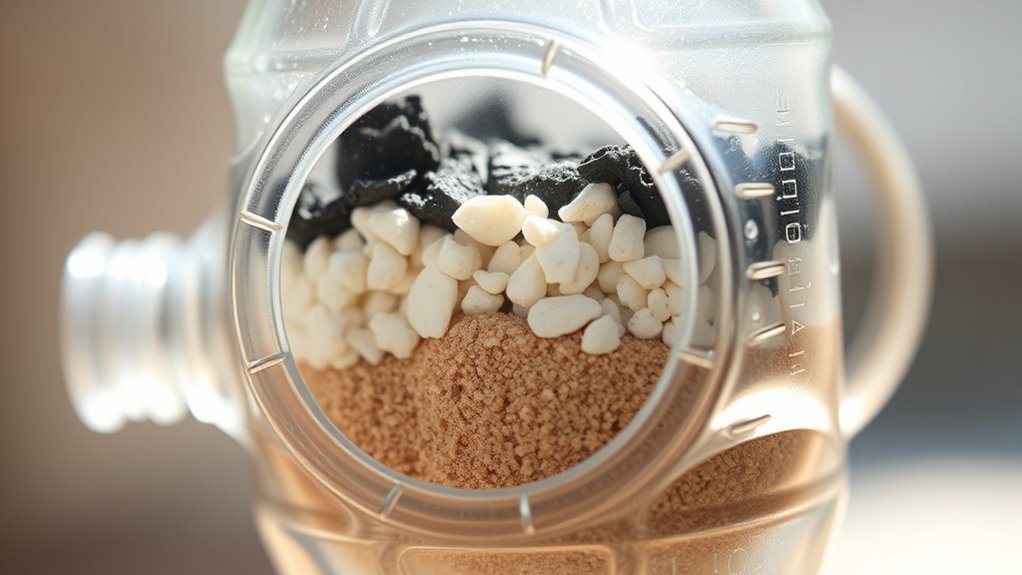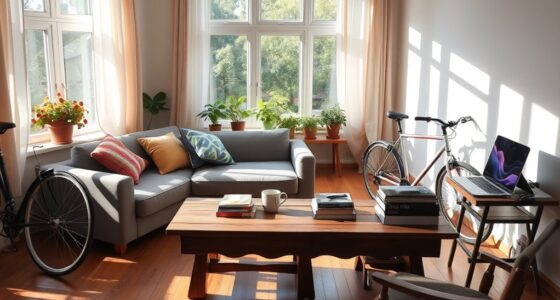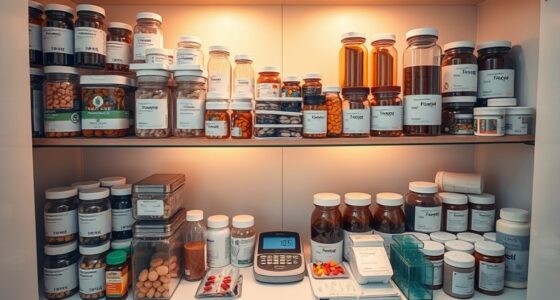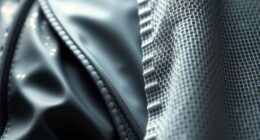In emergencies, you can create safe drinking water using simple DIY filtration with household items. Start with a plastic bottle cut and inverted as a filter housing, adding layers like gravel, activated charcoal, and fine sand or cloth to trap debris and reduce contaminants. Always boil the filtered water for at least a minute to kill pathogens. Combining these steps makes water safer to drink, and more helpful tips await if you stay engaged.
Key Takeaways
- DIY water filters using household materials can improve water clarity and reduce certain contaminants.
- Layering gravel, activated charcoal, and sand effectively captures debris and some chemicals.
- Always boil filtered water for at least one minute to eliminate bacteria and viruses.
- Combining filtration with boiling or chemical treatment ensures safer drinking water during crises.
- Proper assembly and additional treatments are necessary, as DIY filters do not remove all pathogens or pollutants.

Have you ever wondered how to make clean drinking water at home without expensive equipment? In times of crisis or when access to safe water is limited, knowing simple DIY methods can be a lifesaver. The good news is that you can create effective filtration systems using common household items. These methods won’t replace professional purification in every situation, but they can substantially improve water quality and reduce harmful contaminants.
Start with a basic two-stage filter using materials you probably already have. First, find a clean container or bottle to serve as your filter housing. Cut the bottom off a plastic bottle and turn it upside down so the opening faces downward. This will act as your filter chamber. Fill the neck with a layer of small rocks or gravel. This layer helps trap larger debris like dirt, leaves, and twigs, preventing them from passing through. Next, add a layer of activated charcoal—ideally from burned and cooled charcoal briquettes—on top of the gravel. Activated charcoal is excellent at absorbing chemicals, odors, and toxins, making your water safer to drink. If you don’t have activated charcoal, you can use charcoal from a fire, but make sure it’s free from chemicals or additives.
Above the charcoal, add a layer of fine sand or a clean cloth to catch smaller particles. Once assembled, pour water slowly into the top of your homemade filter. As water filters through the layers, larger particles are trapped, and chemicals are absorbed by the charcoal. The water that drips out from the bottle’s spout will be clearer and more purified, but it still needs to be treated further to ensure safety. Boiling the filtered water for at least one minute is essential to kill bacteria, viruses, and other pathogens that may still be present. Incorporating knowledge of water treatment methods can further enhance the safety of your drinking water.
While this DIY filter improves water clarity and reduces some contaminants, it’s not foolproof against all pathogens or chemical pollutants. For added safety, consider using water purification tablets or drops after filtering and boiling. In emergency situations, combining filtration with boiling is your best bet for producing safe drinking water. Remember, no homemade filter replaces professional treatment methods, but it can serve as a reliable stopgap until you can access better options. By understanding and applying these simple steps, you gain a critical skill that ensures you can produce safe drinking water during any crisis, giving you peace of mind and protecting your health when it matters most.
Frequently Asked Questions
Can Homemade Filters Remove All Types of Bacteria?
Homemade filters can’t remove all types of bacteria completely. While they can reduce some bacteria and contaminants, they often lack the precision needed to eliminate all harmful microorganisms. To improve safety, combine filtration with boiling or chemical treatments. Always be cautious, especially in emergencies, and consider using tested commercial filters or purification tablets for guaranteed protection. Relying solely on DIY filters may leave you vulnerable to health risks.
How Long Does a DIY Filter Last Before Replacement?
A DIY water filter typically lasts about one to two months before you should replace or clean it, depending on usage and water quality. You’ll notice reduced flow or clarity as signs it needs maintenance. Regularly check your filter’s components, like charcoal and sand, and replace them when they become clogged or discolored. Proper maintenance guarantees your filter continues to improve water safety and taste effectively.
Is Boiling Water Necessary After DIY Filtration?
Boiling water isn’t always necessary after DIY filtration, but it’s a smart safety step, especially if you’re unsure about your filter’s effectiveness. Think of it as the superhero cape for your clean water—extra protection against unseen germs. If your filter is new and well-maintained, boiling might be overkill. However, in emergencies or uncertain situations, boiling guarantees your water is thoroughly disinfected, keeping you safe and healthy.
Can I Use Cloth Filters for Large Water Volumes?
Yes, you can use cloth filters for large water volumes. They’re effective for removing larger debris and some pathogens, making water visually cleaner. To improve filtration, opt for tightly woven fabrics like cotton or microfiber, and consider layering multiple cloths for better results. Keep in mind, cloth filters don’t eliminate all bacteria or viruses, so follow up with boiling or chemical treatments if possible, especially in emergency situations.
What Are the Signs of a Failed Water Filter?
You’ll notice a failed water filter if the water flow slows markedly or stops altogether. If the water looks cloudy, murky, or has an unusual smell or taste, those are red flags too. Also, if you see particles or sediment passing through, it’s a sign the filter isn’t working properly. Regular maintenance and timely replacement keep your filter effective and your water safe to drink.
Conclusion
When you build your own filter, you gain confidence, save resources, and guarantee safety. When you understand the process, you can adapt easily, troubleshoot quickly, and trust your water. When you take control, you stay prepared, stay safe, and stay healthy. DIY filtration empowers you to face any crisis with clarity, resilience, and independence. Remember, with simple tools and a little know-how, you can turn dirty water into trusted hydration whenever you need it most.










